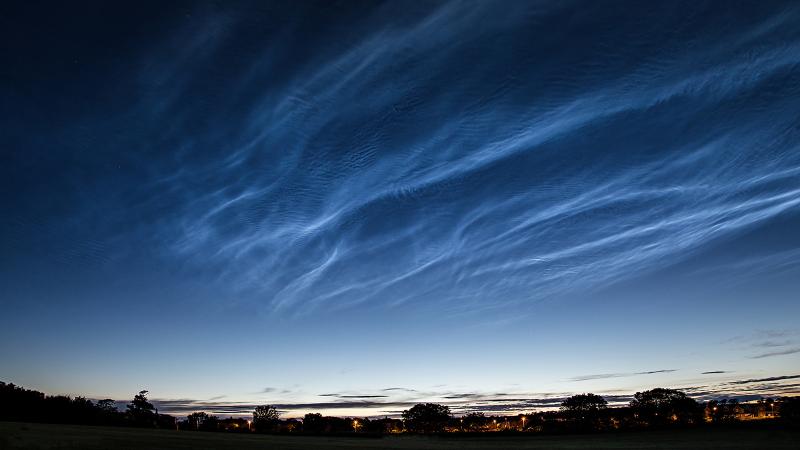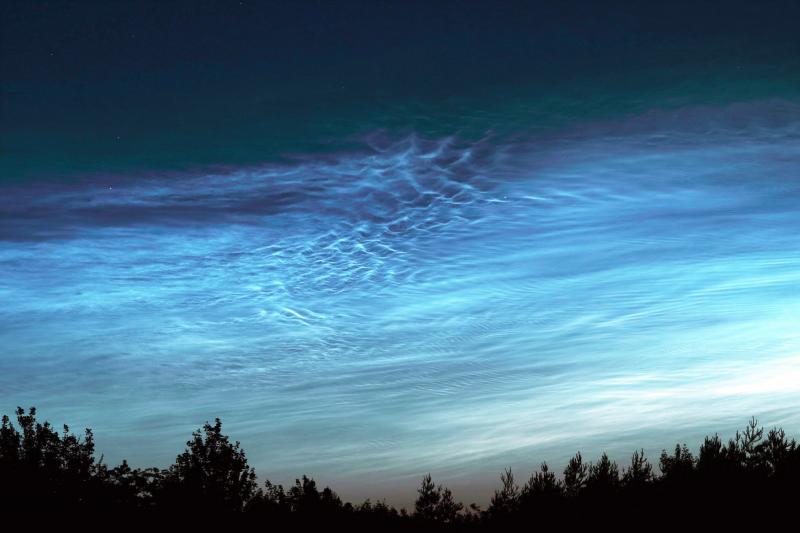Noctilucent cloud over Britain & Western Europe, 2019
2021 May 31

Introduction
For a number of years, displays of noctilucent cloud (NLC) have been seen frequently between the end of May and the middle of August at higher latitudes in the northern hemisphere. Despite deteriorating sky conditions, especially in recent years, an increasing number of observers throughout the UK and Western Europe keenly anticipate the beginning of the NLC season. In addition to the network of ground-based observers, the Aeronomy of Ice in the Mesosphere (AIM) satellite, launched by NASA in 2007, has been monitoring ice as it develops in the mesosphere. This is recorded daily by the Cloud Imaging and Particle Size (CIPS) instrument and is of assistance to ground-based observers in helping to confirm sightings, especially in the early part of the season when ice is not uniformly distributed round the polar region.1
Analysis of observations
A report from Rob Stammes of Polarlightcentre, Lofoten, Norway indicated that polar mesospheric summer echoes (PMSEs) were recorded on May 19/20. It is suggested that the forming ice particles are electrically charged and reflect radio waves. PMSEs do not directly correlate with the appearance of NLC, although they have previously been recorded shortly before NLC sightings.
A trace of ice in the mesosphere appeared to be visible in the CIPS image of May 20 at around the 10 o’clock position; it was so small that it may have been an artefact. However, the CIPS image for May 21 showed a distinct, if small, area of ice in a position which suggests that the feature seen on May 20 was indeed ice. As expected from previous years, three reports were received of NLC on the night of May 22/23, the most southerly being at Rostock, Germany, at a latitude of 54°N. The author, in Dundee, Scotland, first recorded NLC on May 24/25 and reported this to Prof Cora Randall at the Laboratory for Atmospheric and Space Physics (LASP), University of Colorado. Prof Randall replied: ‘Definitely very nice NLCs in your image! There appears to be some planetary wave activity that’s making the clouds seen in CIPS images rotate around the globe, but they are certainly increasing in brightness and extent very rapidly.’2

There was indeed a rapid increase of ice in the mesosphere towards the end of May and into June;1 the reported frequency rose to something of a minor peak on Jun 8/9 & 9/10 when NLC was seen from a latitude of 46°N in Romania. Early indications given by frequency of sightings and the more southerly latitudes of them at an early date tended to suggest an active start to the NLC season. Sightings remained relatively high, with 45 reports on Jun 17/18 and then a remarkable 104 on Jun 21/22. This particular display was outstanding, not just because of its brightness but also because it was seen so early in the evening. Many observers reported sighting NLC as soon as the sky became dark enough and it was described by a number of those in the UK as appearing overhead from their location. This display was seen extensively, as far as the southernmost counties of England. A particular feature commented on by many was the rapidity with which it dispersed shortly after midnight UT. The author experienced this when transporting camera and tripod to his north-facing flat roof; by the time this was reached, the bright display had faded significantly. This led him to enquire of Prof Randall if she had any explanation for the rapid fading. The following was her reply: ‘I don’t have a definitive explanation. It is certainly possible, as you suggest, that there was a steep vertical gradient in temperature, and that the air mass containing the ice might have dropped to an altitude where it was warm enough for the ice to sublimate.’ Prof Randall’s reply ended with an interesting comment: ‘This is definitely a curious year – it seems that water vapor [sic] is unusually high compared to other years, but we don’t yet have an explanation for that’.2
(Login or click above to view the full illustrated article in PDF format)
| The British Astronomical Association supports amateur astronomers around the UK and the rest of the world. Find out more about the BAA or join us. |
